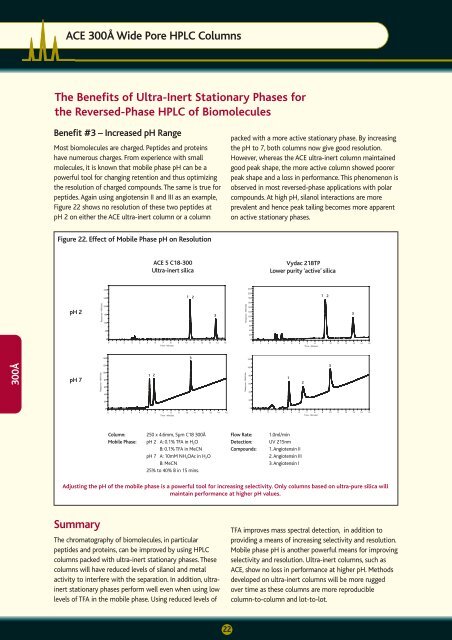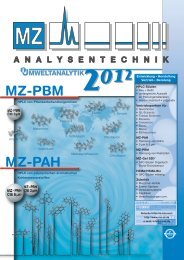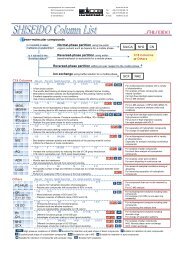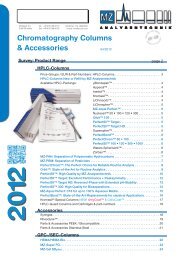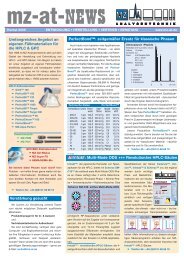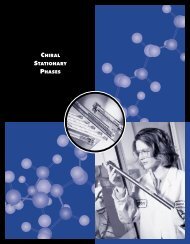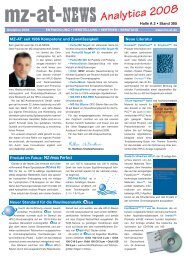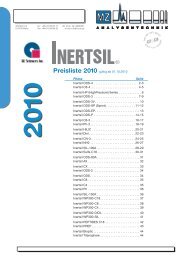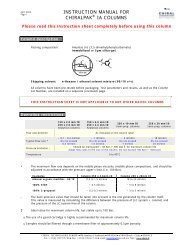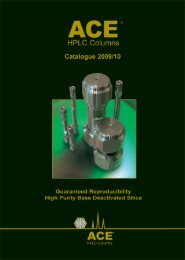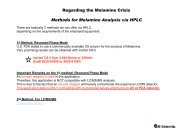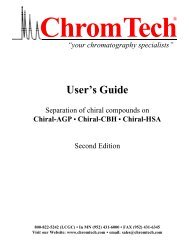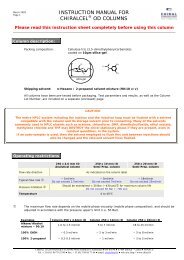Create successful ePaper yourself
Turn your PDF publications into a flip-book with our unique Google optimized e-Paper software.
300Å<br />
<strong>ACE</strong> 300Å Wide Pore HPLC Columns<br />
The Benefits of Ultra-Inert Stationary Phases for<br />
the Reversed-Phase HPLC of Biomolecules<br />
Benefit #3 – Increased pH Range<br />
Most biomolecules are charged. Peptides and proteins<br />
have numerous charges. From experience with small<br />
molecules, it is known that mobile phase pH can be a<br />
powerful tool for changing retention and thus optimizing<br />
the resolution of charged compounds. The same is true for<br />
peptides. Again using angiotensin II and III as an example,<br />
Figure 22 shows no resolution of these two peptides at<br />
pH 2 on either the <strong>ACE</strong> ultra-inert column or a column<br />
Figure 22. Effect of Mobile Phase pH on Resolution<br />
pH 2<br />
pH 7<br />
<strong>ACE</strong> 5 C18-300<br />
Ultra-inert silica<br />
Column: 250 x 4.6mm, 5µm C18 300Å<br />
Mobile Phase: pH 2 A: 0.1% TFA in H 2O<br />
B: 0.1% TFA in MeCN<br />
pH 7 A: 10mM NH 4OAc in H 2O<br />
B: MeCN<br />
25% to 40% B in 15 mins.<br />
22<br />
packed with a more active stationary phase. By increasing<br />
the pH to 7, both columns now give good resolution.<br />
However, whereas the <strong>ACE</strong> ultra-inert column maintained<br />
good peak shape, the more active column showed poorer<br />
peak shape and a loss in performance. This phenomenon is<br />
observed in most reversed-phase applications with polar<br />
compounds. At high pH, silanol interactions are more<br />
prevalent and hence peak tailing becomes more apparent<br />
on active stationary phases.<br />
Vydac 218TP<br />
Lower purity ‘active’ silica<br />
Flow Rate: 1.0ml/min<br />
Detection: UV 215nm<br />
Compounds: 1. Angiotensin II<br />
2. Angiotensin III<br />
3. Angiotensin I<br />
Adjusting the pH of the mobile phase is a powerful tool for increasing selectivity. Only columns based on ultra-pure silica will<br />
maintain performance at higher pH values.<br />
Summary<br />
The chromatography of biomolecules, in particular<br />
peptides and proteins, can be improved by using HPLC<br />
columns packed with ultra-inert stationary phases. These<br />
columns will have reduced levels of silanol and metal<br />
activity to interfere with the separation. In addition, ultrainert<br />
stationary phases perform well even when using low<br />
levels of TFA in the mobile phase. Using reduced levels of<br />
1 2<br />
1 2<br />
3<br />
3<br />
1<br />
2<br />
TFA improves mass spectral detection, in addition to<br />
providing a means of increasing selectivity and resolution.<br />
Mobile phase pH is another powerful means for improving<br />
selectivity and resolution. Ultra-inert columns, such as<br />
<strong>ACE</strong>, show no loss in performance at higher pH. Methods<br />
developed on ultra-inert columns will be more rugged<br />
over time as these columns are more reproducible<br />
column-to-column and lot-to-lot.<br />
1 2<br />
3<br />
3


